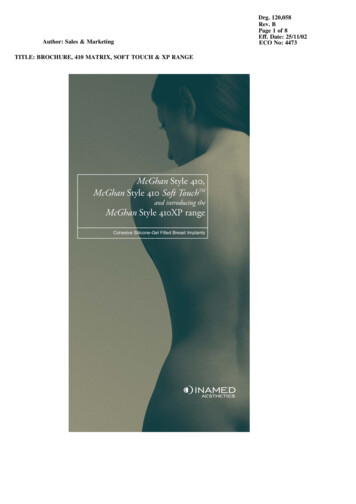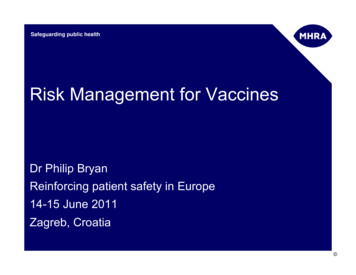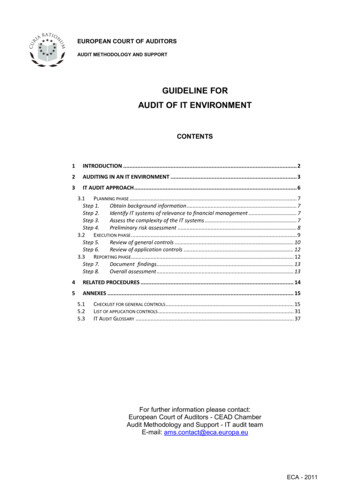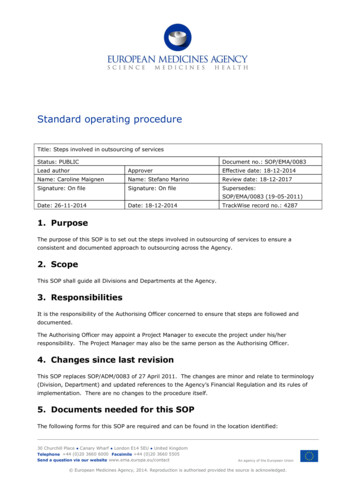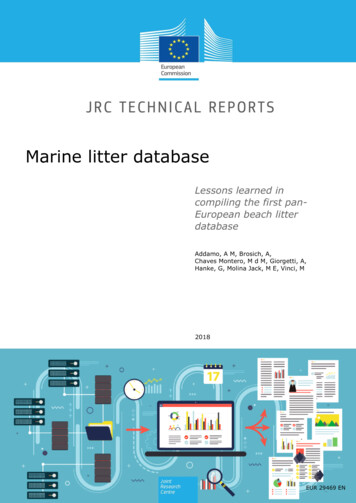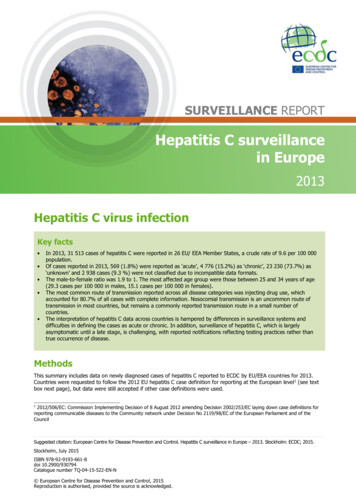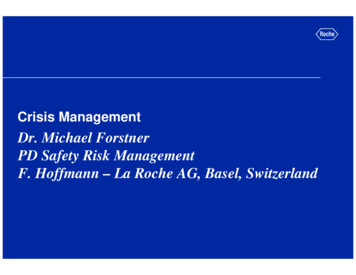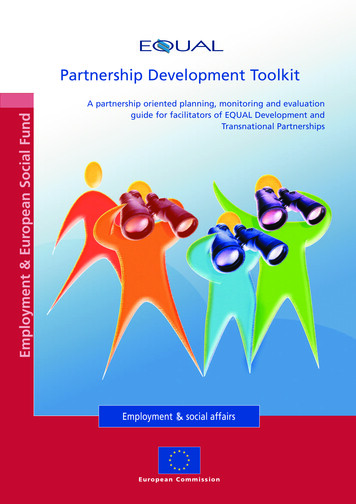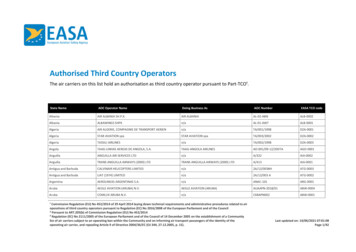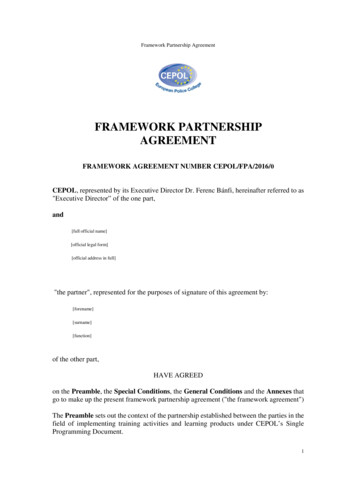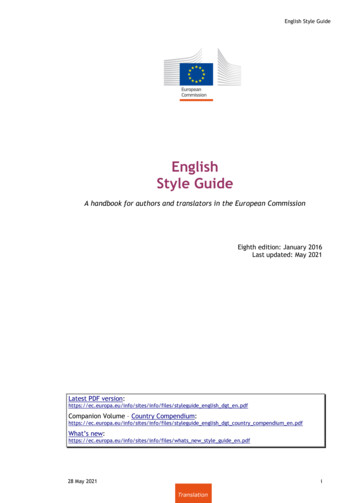
Transcription
English Style GuideEnglishStyle GuideA handbook for authors and translators in the European CommissionEighth edition: January 2016Last updated: May 2021Latest PDF /styleguide english dgt en.pdfCompanion Volume – Country les/styleguide english dgt country compendium en.pdfWhat’s ts new style guide en.pdf28 May 2021iTranslation
English Style Guide European Union, 2016, 2021. The reproduction and reuse of this document is authorised,provided the sources and authors are acknowledged and the original meaning or message of thetexts are not distorted. The right holders and authors shall not be liable for any consequencesstemming from the reuse.ii28 May 2021
English Style GuideCONTENTSEnglish Style Guide. iIntroduction .4Part I Writing English .71.General . 82.Punctuation . 8Full stop . 8Colon . 9Semicolon . 9Comma . 10Dashes . 13Brackets . 13Question mark . 14Exclamation mark . 14Quotation marks . 15Forward slash . 16Apostrophe . 173.Spelling . 18Conventions. 18Interference effects . 21Compound words and hyphens . 224.Capitalisation . 245.Names and titles . 30Personal names and titles . 30Names of bodies . 31Names of ships, aircraft and other vehicles . 33Geographical names . 336.Numbers . 36Writing out numbers . 36Serial numbers . 38Fractions and percentages . 39Ranges . 40Dates and times . 407.Abbreviations, symbols and units of measurement . 42Abbreviations . 42Mathematical symbols . 46Scientific symbols and units of measurement . 4728 May 2021i
English Style Guide8.9.10.11.12.13.14.15.16.Currencies . 48Foreign imports. 49Foreign words and phrases in English text . 49Romanisation systems . 50Parts of speech . 51Adjectives and adverbs . 51Nouns: singular or plural. 53Verbs: present perfect/simple past . 54Verbs: tenses in minutes . 55Verbs: usage in legislation, contracts and the like . 56Verbs: split infinitive . 58Verbs: the -ing form and the possessive . 58Conjunctions . 59Lists . 60Legal language . 61Footnotes, citations and references . 62Correspondence . 64Inclusive language . 65Science guide. 68Part II About the European Union . 7217. The European Union . 7318. Primary legislation . 74The treaties – an overview . 74The treaties in detail . 75Treaty citations . 7819. Secondary legislation . 79Legislative procedures . 79Titles and numbering . 80Structure of acts . 84Referring to subdivisions of acts . 8620. The EU institutions. 86Commission . 86Council . 88European Council . 89European Parliament . 89Court of Justice of the European Union . 90European Court of Auditors . 93European Economic and Social Committee. 93Committee of the Regions. 93ii28 May 2021
English Style Guide21.22.23.24.25.European Central Bank . 94Other financial institutions . 94Interinstitutional bodies . 94Agencies . 95References to official publications . 95The Official Journal . 95General Report and Bulletin. 96EU finances . 96Budget . 96Funds financed from the budget . 97Other funds . 98Member States . 98Permanent Representations/Representatives . 99National parliaments . 99National judicial bodies. 100National legislation . 100Official languages . 102External relations . 103Annexes . 106Annex 1International organisations whose names do not follow ourstandard spelling rules . 107Annex 2Transliteration table for Greek . 109Annex 3Conversion table for Greek serial numbering . 112Annex 4Transliteration table for Cyrillic . 114Annex 5Conversion table for Bulgarian serial numbering. 117Annex 6Conversion table for numbering of inserted articles . 118Annex 7Forms of address . 119Companion volume:Country Compendium28 May 2021iii
English Style GuideIntroductionThis Style Guide is intended primarily for English-language authors and translators,both in-house and freelance, working for the European Commission. But now that somany texts in and around the EU institutions are drafted in English by native andnon-native speakers alike, its rules, reminders and handy references aim to serve a widerreadership as well.In this Guide, ‘style’ is synonymous with a set of accepted linguistic conventions; ittherefore refers to recommended in-house usage, not to literary style. Excellent adviceon how to improve writing style is given in The Plain English Guide by Martin Cutts(Oxford University Press, 1999) and Style: Toward Clarity and Grace by Joseph M.Williams (University of Chicago Press, 1995), and the European Commission’s ownHow to write clearly, all of which encourage the use of good plain English. See alsoClear English - Tips for Translators, Tips on translating from Slovak into English andMisused English words and expressions in EU publications.For reasons of stylistic consistency, the variety of English on which this Guide bases itsinstructions and advice is the standard usage of Britain and Ireland (for the sake ofconvenience, called ‘British usage’ or ‘British English’ in this Guide).The Guide is divided into two clearly distinct parts, the first dealing with linguisticconventions applicable in all contexts and the second with the workings of the EuropeanUnion – and with how those workings are expressed and reflected in English. Thisshould not be taken to imply that ‘EU English’ is different from ‘real English’; it issimply a reflection of the fact that the European Union as a unique body has had toinvent a terminology to describe itself. However, the overriding aim in both parts of theGuide is to facilitate and encourage the writing of clear and reader-friendly English.Wr
This Style Guide is intended primarily for English-language authors and translators, both in-house and freelance, working for the European Commission. But now that so many texts in and around the EU institutions are drafted in English by native and non-native speakers alike, its rules, reminders and handy references aim to serve a wider readership as well. In this Guide, ‘style’ is .

